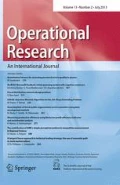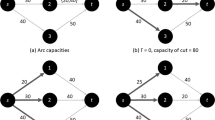Abstract
Many decision-making problems in transportation networks can be defined as maximum flow problems. During the last five decades, several efficient solution approaches have been proposed for the deterministic maximum flow problems. On the other hand, arc capacities of networks cannot be precisely defined in many real life settings. These networks are called uncertain. In this case, it becomes challenging to maintain a stable flow on the network. This paper presents a new approach based on the framework of interval analysis for the solution of maximum flow problems. We address a multiple-owners network problem by presenting a risk explicit interval linear programming model for the desired value of the system aspiration level. Afterwards, we employ a well-known collaborative game theoretic approach (the Shapley value) in a multiple-owners network under interval uncertainty in order to solve the maximum flow problem. A detailed numerical example is provided to present the suitability of the proposed approach in devising a stable network flow. The obtained numerical results and the trade-offs between decision risk and network flow information would be very valuable for supporting decision makers in resolving maximum flow problems when facing uncertainty.









Similar content being viewed by others
References
Allahdadi M, Nehi HM, Ashayerinasab HA, Javanmard M (2016) Improving the modified interval linear programming method by new techniques. Inf Sci 339:224–236
Asano T, Asano Y (2000) Recent developments in maximum flow algorithms. J Oper Res Soc Jpn 43:2–31
Ashayerinasab HA, Nehi HM, Allahdadi M (2018) Solving the interval linear programming problem: a new algorithm for a general case. Expert Syst Appl 93:39–49
Aumann RJ, Maschler M (1964) The bargaining set for cooperative games. Adv Game Theory 52:443–476
Bachrach Y, Rosenschein J (2009) Power in threshold network flow games. Auton Agent Multi-Agent Syst 18:106–132
Bai L, Li F, Cui H, Jiang T, Sun H, Zhu J (2016) Interval optimization based operating strategy for gas-electricity integrated energy systems considering demand response and wind uncertainty. Appl Energy 167:270–279
Banez-Chicharro F, Olmos L, Ramos A, Latorre JM (2017) Estimating the benefits of transmission expansion projects: an Aumann–Shapley approach. Energy 118:1044–1054
Baykasoğlu A, Özbel BK (2016) Cooperative interval game theory and the grey Shapley value approach for solving the maximum flow problem XIV. International Logistics and Supply Chain Congress Izmir Turkey ISBN:978-605-338-186-0, pp 53–63
Ben-Tal A, Goryashko A, Guslitzer E, Nemirovski A (2004) Adjustable robust solutions of uncertain linear programs. Math Program 99:351–376
Bernoulli D (1954) Exposition of a new theory on the measurement of risk. Econometrica 22:23–36
Branzei R, Branzei O, Gök SZA, Tijs S (2010) Cooperative interval games: a survey. Cent Eur J Oper Res 18:397–411
Branzei R, Gök SA, Branzei O (2011) Cooperative games under interval uncertainty: on the convexity of the interval undominated cores. Cent Eur J Oper Res 19:523–532
Chakra MA, Traulsen A (2012) Evolutionary dynamics of strategic behavior in a collective-risk dilemma. PLoS Comput Biol 8:e1002652
Chakra MA, Traulsen A (2014) Under high stakes and uncertainty the rich should lend the poor a helping hand. J Theor Biol 341:123–130
Chanas S, Kolodziejczyk W (1986) Integer flows in network with fuzzy capacity constraints. Networks 16:17–31
Chanas S, Kołodziejczyk W (1982) Maximum flow in a network with fuzzy arc capacities. Fuzzy Sets Syst 8:165–173
Chanas S, Kołodziejczyk W (1984) Real-valued flows in a network with fuzzy arc capacities. Fuzzy Sets Syst 13:139–151
Charnes A, Cooper WW (1959) Chance-constrained programming. Manag Sci 6:73–79
Chen X, Szolnoki A, Perc M (2012a) Averting group failures in collective-risk social dilemmas. EPL (Europhys Lett) 99:68003
Chen X, Szolnoki A, Perc M (2012b) Risk-driven migration and the collective-risk social dilemma. Phys Rev E 86:036101
Conitzer V, Sandholm T (2006) Complexity of constructing solutions in the core based on synergies among coalitions. Artif Intell 170(6–7):607–619
Dantzig GB (1955) Linear programming under uncertainty. Manag Sci 1:197–206
Deng X, Papadimitriou CH (1994) On the complexity of cooperative solution concepts. Math Oper Res 19:257–266
Diamond P (2001) A fuzzy max-flow min-cut theorem. Fuzzy Sets Syst 119:139–148
Evans J (1976) Maximum flow in probabilistic graphs-the discrete case. Networks 6:161–183
Fishman GS (1987) The distribution of maximum flow with applications to multistate reliability systems. Oper Res 35:607–618
Ford LR, Fulkerson DR (1956) Maximal flow through a network. Can J Math 8:399–404
Frisk M, Göthe-Lundgren M, Jörnsten K, Rönnqvist M (2010) Cost allocation in collaborative forest transportation. Eur J Oper Res 205:448–458
Goldberg AV, Tarjan RE (1988) A new approach to the maximum-flow problem. J ACM (JACM) 35:921–940
Hafezalkotob A, Makui A (2015) Cooperative maximum-flow problem under uncertainty in logistic networks. Appl Math Comput 250:593–604
Hammons TJ (2001) Electricity restructuring in Latin America systems with significant hydro generation. Rev Energ Ren, Power Eng, pp 39–48
Han W-B, Sun H, Xu G-J (2012) A new approach of cooperative interval games: the interval core and Shapley value revisited. Oper Res Lett 40:462–468
Hauser OP, Rand DG, Peysakhovich A, Nowak MA (2014) Cooperating with the future. Nature 511:220–223
Heidari Gharehbolagh H, Hafezalkotob A, Makui A, Raissi S (2017) A cooperative game approach to uncertain decentralized logistic systems subject to network reliability considerations. Kybernetes 46:1452–1468
Hilbe C, Chakra MA, Altrock PM, Traulsen A (2013) The evolution of strategic timing in collective-risk dilemmas. PloS ONE 8:e66490
Huang YF, Ye WL, Zhou FF (2013) Research on the profit distribution of logistics company strategic alliance based on Shapley value. Adv Mater Res Trans Tech Publ 765:3253–3257
Huang H, Li F, Mishra Y (2015) Modeling dynamic demand response using monte carlo simulation and interval mathematics for boundary estimation. IEEE Trans Smart Grid 6:2704–2713
Jacquet J, Hagel K, Hauert C, Marotzke J, Röhl T, Milinski M (2013) Intra-and intergenerational discounting in the climate game Nature. Clim Change 3:1025–1028
James J, Leonard J (2008) Fuzzy max-flow problem. Stud Fuzz Soft Comput 222:195–198
Ji X, Yang L, Shao Z (2006) Chance constrained maximum flow problem with fuzzy arc capacities. Lect Notes Comput Sci 4114:11–19
Ju-Long D (1982) Control problems of grey systems. Syst Control Lett 1:288–294
Kalai E, Zemel E (1982a) Generalized network problems yielding totally balanced games. Oper Res 30:998–1008
Kalai E, Zemel E (1982b) Totally balanced games and games of flow. Math Oper Res 7:476–478
Koch T, Hiller B, Pfetsch, M E, Schewe L (2015) Evaluating gas network capacities. SIAM-MOS series on Optimization. SIAM 21:xvii + 364
Kopustinskas V, Praks P (2015) Probabilistic gas transmission network simulator and application to the EU gas transmission system. J Polish Safe Reliab Assoc 6:71–78
Leech D (2003) Computing power indices for large voting games. Manage Sci 49:831–837
Li DF, Ye YF (2018) Interval-valued least square prenucleolus of interval-valued cooperative games and a simplified method. Oper Res Int J 18:205–220
Lozano S, Moreno P, Adenso-Díaz B, Algaba E (2013) Cooperative game theory approach to allocating benefits of horizontal cooperation. Eur J Oper Res 229:444–452
Mallozzi L, Scalzo V, Tijs S (2011) Fuzzy interval cooperative games. Fuzzy Sets Syst 165:98–105
Mann I, Shapley LS (1960) Values of large games IV: evaluating the electoral college by montecarlo techniques. RAND Corporation
Milinski M, Sommerfeld RD, Krambeck HJ, Reed FA, Marotzke J (2008) The collective-risk social dilemma and the prevention of simulated dangerous climate change. Proc Natl Acad Sci 105:2291–2294
Milinski M, Röhl T, Marotzke J (2011) Cooperative interaction of rich and poor can be catalyzed by intermediate climate targets. Clim Change 109:807–814
Minoux M (2009) On robust maximum flow with polyhedral uncertainty sets. Optim Lett 3:367–376
Minoux M (2010) Robust network optimization under polyhedral demand uncertainty is NP-hard. Discret Appl Math 158:597–603
Nagamochi H, Zeng D, Kabutoya N, Ibaraki T (1997) Complexity of the minimum base game on matroids. Math Oper Res 22:146–164
Nawathe S, Rao B (1980) Maximum flow in probabilistic communication networks. Int J Circuit Theory Appl 8:167–177
Nowak MA (2006) Five rules for the evolution of cooperation. Science 314:1560–1563
Ordóñez F, Zhao J (2007) Robust capacity expansion of network flows. Networks 50:136–145
Owen G (1972) Multilinear extensions of games. Manage Sci 18:64–79
Praks P, Kopustinskas V, Masera M (2015) Probabilistic modelling of security of supply in gas networks and evaluation of new infrastructure. Reliab Eng Syst Safe 144:254–264
Quiggin J (2012) Generalized expected utility theory: the rank-dependent model. Springer, Berlin
Raihani N, Aitken D (2011) Uncertainty, rationality and cooperation in the context of climate change. Clim Change 108:47–55
Ramesh G, Ganesan K (2011) Interval linear programming with generalized interval arithmetic. Int J Sci Eng Res 2:1–8
Raub W, Snijders C (1997) Gains, losses, and cooperation in social dilemmas and collective action: the effects of risk preferences. J Math Sociol 22:263–302
Reyes PM (2005) Logistics networks: a game theory application for solving the transshipment problem. Appl Math Comput 168:1419–1431
Rosenthal EC (2017) A cooperative game approach to cost allocation in a rapid-transit network. Transp Res B: Methodol 97:64–77
Sabater-Grande G, Georgantzis N (2002) Accounting for risk aversion in repeated prisoners’ dilemma games: an experimental test. J Econ Behav Organ 48:37–50
Santos FC, Pacheco JM (2011) Risk of collective failure provides an escape from the tragedy of the commons. Proc Natl Acad Sci 108:10421–10425
Schmeidler D (1969) The nucleolus of a characteristic function game SIAM. J Appl Math 17:1163–1170
Sengupta A, Pal TK, Chakraborty D (2001) Interpretation of inequality constraints involving interval coefficients and a solution to interval linear programming. Fuzzy Sets Syst 119:129–138
Shaocheng T (1994) Interval number and fuzzy number linear programmings. Fuzzy Sets Syst 66:301–306
Shapley LS (1953) A value for n-person games. Ann Math Stud 28:307–317
Shapley LS, Shubik M (1954) A method for evaluating the distribution of power in a committee system. Am Polit Sci Rev 48:787–792
Sheng Y, Gao J (2014) Chance distribution of the maximum flow of uncertain random network. J Uncert Anal Appl 2:1–15
Sohrabi MK, Azgomi H (2018) A survey on the combined use of optimization methods and game theory. Arch Comput Methods Eng. https://doi.org/10.1007/s11831-018-9300-5
Tang Z-Y, Tang B-B (2001) The maximum flow problem with fuzzy constraints. Fuzzy Syst Math 15:77–80
Tavoni A, Dannenberg A, Kallis G, Löschel A (2011) Inequality, communication, and the avoidance of disastrous climate change in a public goods game. Proc Natl Acad Sci 108:11825–11829
Tran TH, French S, Ashman R, Kent E (2018) Impact of compressor failures on gas transmission network capability. Appl Math Model 55:741–757
Tversky A, Kahneman D (1992) Advances in prospect theory: cumulative representation of uncertainty. J Risk Uncert 5:297–323
Van Assen M, Snijders C (2004) Effects of risk preferences in social dilemmas: a game-theoretical analysis and evidence from two experiments. Contemp Psychol Res Soc Dilemmas 38–65
Vasconcelos VV, Santos FC, Pacheco JM (2013) A bottom-up institutional approach to cooperative governance of risky commons Nature. Clim Change 3:797–801
Vasconcelos VV, Santos FC, Pacheco JM, Levin SA (2014) Climate policies under wealth inequality. Proc Natl Acad Sci 111:2212–2216
Von Neumann J, Morgenstern O (2007) Theory of games and economic behavior. Princeton University Press, Princeton
Wang X, Huang G (2014) Violation analysis on two-step method for interval linear programming. Inf Sci 281:85–96
Wang J, Fu F, Wang L (2010) Effects of heterogeneous wealth distribution on public cooperation with collective risk. Phys Rev E 82:016102
Zhou F, Huang GH, Chen GX, Guo HC (2009) Enhanced-interval linear programming. Eur J Oper Res 199:323–333
Zlotkin G, Rosenschein J (1994) Coalition, cryptography, and stability: mechanisms foe coalition formation in task oriented domains. In: Proceedings of the National Conference on Artificial Intelligence (AAAI-94), pp 432–437
Zou R, Liu Y, Liu L, Guo H (2009) REILP approach for uncertainty-based decision making in civil engineering. J Comput Civil Eng 24:357–364
Acknowledgements
Authors are grateful to the anonymous reviewers and editor for their helpful suggestions that concretely have contributed to ameliorate the paper from its original version.
Author information
Authors and Affiliations
Corresponding author
Additional information
Publisher's Note
Springer Nature remains neutral with regard to jurisdictional claims in published maps and institutional affiliations.
Rights and permissions
About this article
Cite this article
Baykasoğlu, A., Kubur Özbel, B. Explicit flow-risk allocation for cooperative maximum flow problems under interval uncertainty. Oper Res Int J 21, 2149–2179 (2021). https://doi.org/10.1007/s12351-019-00500-5
Received:
Revised:
Accepted:
Published:
Issue Date:
DOI: https://doi.org/10.1007/s12351-019-00500-5




